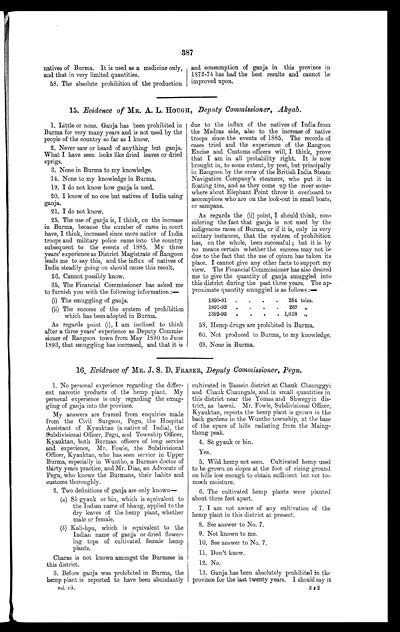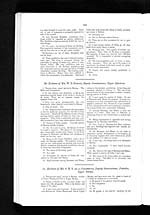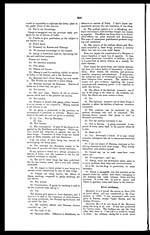Medicine - Drugs > Report of the Indian Hemp Drugs Commission, 1894-1895 > Volume VII > Evidence of Burma witnesses
(405) Page 387
Download files
Individual page:
Thumbnail gallery: Grid view | List view

387
natives of Burma. It is used as a medicine only,
and that in very limited quantities.
58. The absolute prohibition of the production
and consumption of ganja in this province in
1872-74 has had the best results and cannot be
improved upon.
15. Evidence of MR. A. L. HOUGH,Deputy Commissioner, Akyab.
1. Little or none. Ganja has been prohibited in
Burma for very many years and is not used by the
people of the country so far as I know.
2. Never saw or heard of anything but ganja.
What I have seen looks like dried leaves or dried
sprigs.
3. None in Burma to my knowledge
14. None to my knowledge in Burma.
19. I do not know how ganja is used.
20. I know of no one but natives of India using
ganja.
21. I do not know.
25. The use of ganja is, I think, on the increase
in Burma, because the number of cases in court
have, I think, increased since more native of India
troops and military police came into the country
subsequent to the events of 1885. My three
years' experience as District Magistrate of Rangoon
leads me to say this, and the influx of natives of
India steadily going on should cause this result.
26. Cannot possibly know.
35. The Financial Commissioner has asked me
to furnish you with the following information: —
(i) The smuggling of ganja.
(ii) The success of the system of prohibition
which has been adopted in Burma.
As regards point (i), I am inclined to think
after a three years' experience as Deputy Commis-
sioner of Rangoon town from May 1890 to June
1893, that smuggling has increased, and that it is
due to the influx of the natives of India from
the Madras side, also to the increase of native
troops since the events of 1885. The records of
cases tried and the experience of the Rangoon
Excise and Customs officers will, I think, prove
that I am in all probability right. It is now
brought in, to some extent, by post, but principally
in Rangoon by the crew of the British India Steam
Navigation Company's steamers, who put it in
floating tins, and as they come up the river some-
where about Elephant Point throw it overboard to
accomplices who are on the look-out in small boats,
or sampans.
As regards the (ii) point, I should think, con-
sidering the fact that ganja is not used by the
indigenous races of Burma, or if it is, only in very
solitary instances, that the system of prohibition
has, on the whole, been successful; but it is by
no means certain whether the success may not be
due to the fact that the use of opium has taken its
place. I cannot give any other facts to support my
view. The Financial Commissioner has also desired
me to give the quantity of ganja smuggled into
this district during the past three years. The ap-
proximate quantity smuggled is as follows: —
| 1890-91 | 254 | tolas. |
| 1891-92 | 267 | " |
| 1892-93 | 1,018 | " |
58. Hemp drugs are prohibited in Burma.
60. Not produced in Burma, to my knowledge.
68. None in Burma.
16. Evidence of MR. J. S. D. FRASER, Deputy Commissioner, Pegu.
1. No personal experience regarding the differ-
ent narcotic products of the hemp plant. My
personal experience is only regarding the smug-
gling of ganja into the province.
My answers are framed from enquiries made
from the Civil Surgeon, Pegu, the Hospital
Assistant of Kyauktan (a native of India), the
Subdivisional Officer, Pegu, and Township Officer,
Kyauktan, both Burman officers of long service
and. experience, Mr. Fowle, the Subdivisional
Officer, Kyauktan, who has seen service in Upper
Burma, especially in Wuntho, a Burman doctor of
thirty years practice, and Mr. Dias, an Advocate of
Pegu, who knows the Burmans, their habits and
customs thoroughly.
2. Two definitions of ganja are only known—
(a) Sè gyauk or bin, which is equivalent to
the Indian name of bhang, applied to the
dry leaves of the hemp plant, whether
male or female.
(b) Kali-hpu, which is equivalent to the
Indian name of ganja or dried. flower-
ing tops of cultivated female hemp
plants.
Charas is not known amongst the Burmese in
this district.
3. Before ganja was prohibited in Burma, the
hemp plant is reported to have been abundantly
cultivated in Bassein district at Chauk Chaunggyi
and Chauk Chaungale, and. in small quantities in
this district near the Yomas and Shwegyin dis-
trict, as bawni. Mr. Fowle, Subdivisional Officer,
Kyauktan, reports the hemp plant is grown in the
back gardens in the Wuntho township, at the base
of the spurs of hills radiating from the Maing-
thong peak.
4. Sè gyauk or bin.
Yes.
5. Wild hemp not seen. Cultivated hemp used
to be grown on slopes at the foot of rising ground
on hills low enough to obtain sufficient but not too
much moisture.
6. The cultivated hemp plants were planted
about three feet apart.
7. I am not aware of any cultivation of the
hemp plant in this district at present.
8. See answer to No. 7.
9. Not known to me.
10. See answer to No. 7.
11. Don't know.
12. No.
13. Ganja has been absolutely prohibited in the
province for the last twenty years. I should say it
vol. vii.
3v2
Set display mode to: Large image | Zoom image | Transcription
Images and transcriptions on this page, including medium image downloads, may be used under the Creative Commons Attribution 4.0 International Licence unless otherwise stated. ![]()
| India Papers > Medicine - Drugs > Report of the Indian Hemp Drugs Commission, 1894-1895 > Volume VII > Evidence of Burma witnesses > (405) Page 387 |
|---|
| Permanent URL | https://digital.nls.uk/74911813 |
|---|




